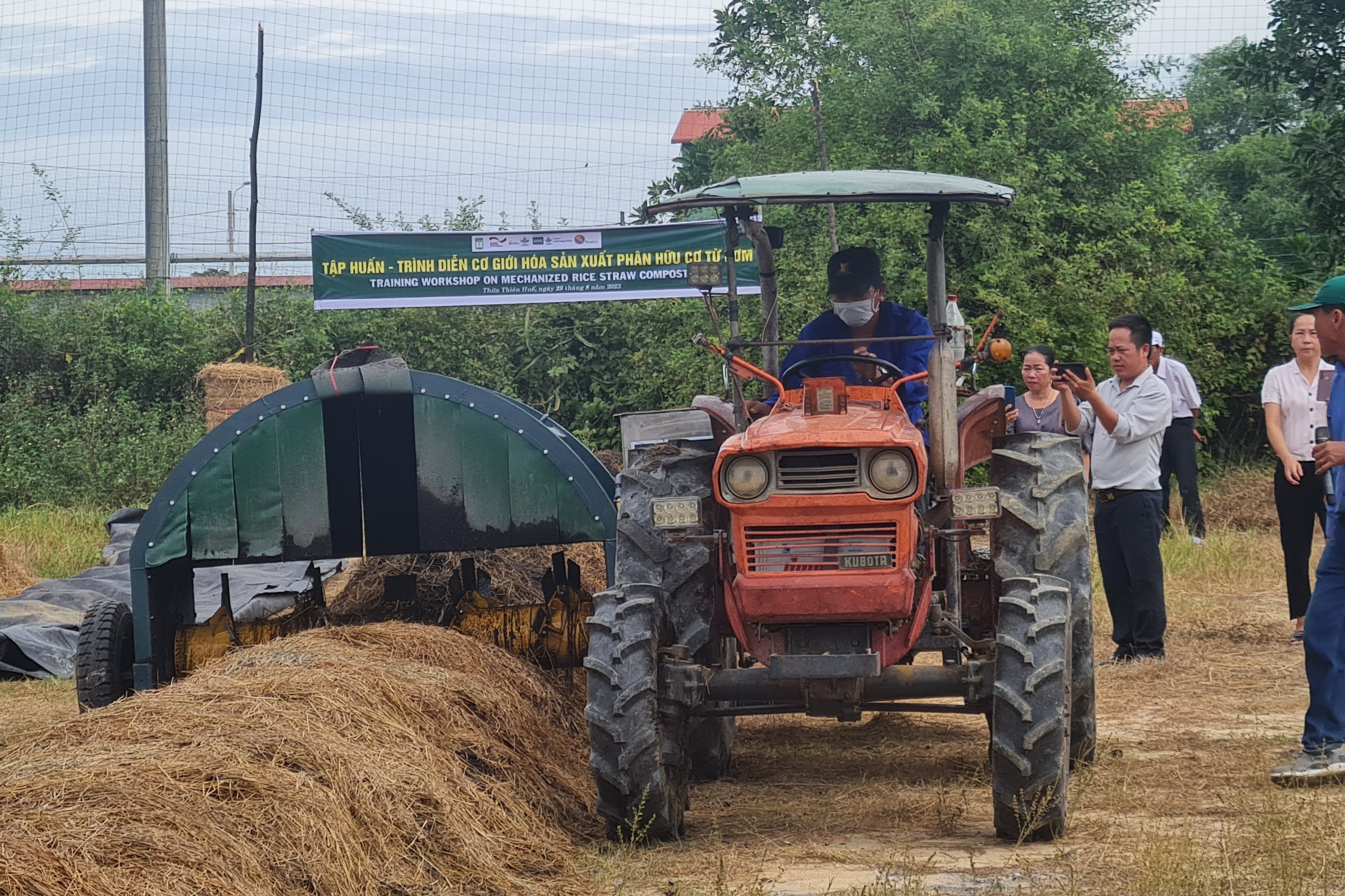Dissertation title: Nutritive improvement of cassava root and its replacement in taro foliage and banana stems basal diets for local pig production in smallholders in Lao PDR
Major: Animal Sciences
Code: 9620105
Author name: Nouphone Manivanh
Supervisors:
1. Associate Professor Dr. Le Van An
2. Associate Professor Dr. Tran Thi Thu Hong
Institutions: Hue University of Agriculture and Forestry
Contribution of the dissertation
The study was aimed at improving protein content of cassava root (Manihot esculenta Crantz) by solid-state fermentation with yeast (Saccharomyces cerevisiae), urea and di-ammonium phosphate (DAP) additive and its utilization as protein source in the diets of Moo Lath Pig in Laos. Four experiments were carried out with “two in cassava root fermentation experiments, two experiments were conducted with Moo Lath pig using taro silage (TS) replaced by protein-enriched cassava root (PECR) as protein sources on growing trial and digestibility. In chapter 2, experiment 1. Cassava root was fermented with yeast, urea and DAP in a solid-state fermentation to determine the degree of conversion of crude to true protein; and experiment 2 the limiting factor to the synthesis of true protein from crude protein in the fermentation of cassava root could be the decrease in pH in the fermentation substrate preventing the hydrolysis of urea to ammonia and thus decreasing the availability of nitrogen for growth of the yeast. The following experiment to determine the degree of conversion of crude to true protein, pH and ammonia. In experiment 1. The experiment was arranged as a 2*3*4 factorial in a completely randomized design (CRD). The treatments were: root processing (steamed and not steamed); DAP: 0, 1 and 2% of the substrate DM. The fermentation was over 14 days with samples taken for determination of true and crude protein (CP) at 0, 3, 7 and 14 days. In experiment 2. A CRD was used with 2 treatments arranged as a 2*9 factorial. The treatments were anaerobic and aerobic fermentation. The substrate was cassava root 93.6% + DAP 2% + urea 1.4% + yeast 3% (DM basis). True, crude protein, ammonia and pH were measured at 0 and 3h after preparing the substrates and every 24h until end of day 7 (0, 3h, 1, 2, 3, 4, 5, 6 and 7 day). Experiment 1 (chapter 2). The true protein (TP) in cassava root increased with a curvilinear trend (R2 = 0.98) from 2.30 to 6.87% in DM as the fermentation time increased from zero to 14 days; the ratio of true to crude protein increased from 24.6 to 63.7 over the same period. Increasing the proportion of DAP from zero to 2% of the substrate DM increased the TP from 5.6 to 7.3% in DM after 14 days of fermentation. Steaming the cassava root prior to fermentation improved slightly (p=0.67) the
conversion of crude to TP. Experiment 2 (chapter 2). The pH decreased with fermentation time, according to an almost linear trend, from 5.8 immediately after mixing the substrate, to 5.47in 3h and to 3.43 after 7 days. The level of CP after mixing the substrate and additives was 10.35% in DM and did not change over the 7 days of fermentation. TP in the substrate increased from 2.37 to 6.97% in DM as the fermentation time increased from zero to 7 days. There were no differences in all these criteria as between the aerobic and anaerobic condition, other than a tendency for the pH to fall slightly more quickly in the first 4 days in the anaerobic condition followed by a slower rate of fall to reach almost the same final value after 7 days, as for the aerobic condition. Experiment 3 (chapter 3). A growth trial was conducted with 12 Moo Lath pigs with average 14.8 ±1.89 kg initial live weight in a CRD, with three replications of four treatments. The aim of the study was to determine the effect of replacing TS with PECR in a basal diet of ensiled banana stem (BS). There were positive responses in dry matter (DM) intake, live weight gain, feed conversion ratio, as the percentage of PECR in the diet was increased (zero to 15% in DM ). It was concluded that the replacing of taro foliage silage with PECR improved the quality of the overall diet, which resulted in higher intake, growth rate, better feed conversion ratio and economical efficiency. Experiment 4 (chapter 4). Four castrated male Moo Lath pig, weighing on average 15 kg were allotted at random to 4 diets within a 4*4 Latin square design, to study effects on DM intake, digestibility and N retention of levels of protein-enriched cassava root (PECR) as 0, 25, 50 and 75% in combination with TS as 80, 55, 30 and 5% with constant levels of ensiled banana stem 20% (all on DM basis). PECR at 25% in a diet led to increases in feed intake, diet digestibility and N retention in native Moo Lath pigs and PECR could be the result of its superior biological value compared with the protein in the taro foliage. These criteria declined linearly when the proportions of PECR were increased to 50 and 75% of the diet DM.
—————————————————————————–
Tên luận án: Làm giàu protein củ sắn bằng cách lên men với nấm men làm thức ăn cho lợn địa phương ở Lào
Ngành: Chăn nuôi
Mã số: 9620105
Họ tên nghiên cứu sinh: Nouphone Manivanh
Người hướng dẫn khoa học:
1. PGS. TS. Lê Văn An
2. PGS. TS. Trần Thị Thu Hồng
Đơn vị đào tạo: Trường Đại học Nông Lâm, Đại học Huế
Những đóng góp mới của luận án
Nghiên cứu của luận án nhằm mục đích cải thiện hàm lượng protein của sắn củ (Manihot esculenta Crantz) khi lên men với các chất phụ gia như nấm men (Saccharomyces cerevisiae), urê và di-ammonium phosphate (DAP); và việc sử dụng sản phẩm sau khi lên men như là một nguồn protein trong khẩu phần nuôi lợn địa phương Mou lath ở Lào. Bốn thí nghiệm đã được triển khai, trong đó hai thí nghiệm lên men sắn củ và hai thí nghiệm sử dụng sắn củ lên men (PECR) thay thế nguồn protein trong khẩu phần lá môn khoai ủ (TS) nuôi lợn địa phương Mou lath và thí nghiệm tiêu hoá ở lợn. Ở thí nghiệm 1 (Chương 2), củ sắn được ủ lên men với nấm men, urê và DAP để xác định khả năng làm giàu protein của khối ủ. Ở thí nghiệm 2 (Chương 2) xác định yếu tố ảnh hưởng đến khả năng tổng hợp protein thật từ quá trình lên men làm giảm độ pH nhằm hạn chế sự thuỷ phân urê thành khí amoniac, nhờ đó lượng nitơ cung cấp cho sinh trưởng của vi sinh vật. Thí nghiệm đã xác định mức độ chuyển hoá từ protein thô thành protein thật, pH và lượng amoniac. Ở thí nghiệm 1 với 6 nghiệm thức được bố trí ngẫu nhiên theo 2 phương pháp chế biến củ sắn (nấu chín và không nấu chín) được phối trộn với 3 mức tỷ lệ DAP (0, 1 và 2% trong VCK). Hỗn hợp được lên men14 ngày và mẫu được lấy để phân tích vào các thời điểm 0, 3, 7 và 14 ngày sau khi ủ. Ở thí nghiệm 2, củ sắn được nấu chín sau đó được trộn với 2% DAP, 1,4% urê và 3% nấm men, sau đó được chia thành 2 lô lên men yếm khí và hiếu khí. Các mẫu lên men được phân tích tại 9 thời điểm khác nhau là 0 giờ, 7 giờ, 1, 2, 3, 4, 5, 6 và 7 ngày. Ở thí nghiệm 1 (Chương 2) hàm lượng protein thật (TP) đã tăng tuyến tính (R2 = 0.98) từ 2,30 đến 6,87% trong VCK khi thời gian ủ từ 0 đến 14 ngày. Tỷ lệ protein thật /protein thô cũng tăng từ 24,6 đến 63,7 trong giai đoạn này. Tăng tỷ lệ DAP từ 0 đến 2% trong vật chất khô khối ủ đã làm tăng lượng TP từ 5,6 đến 7,3% trong VCK sau 14 ngày ủ. Phương pháp nấu chín củ sắn đã làm tăng quá trình chuyển hoá TP so với không nấu nhưng ở mức không sai khác có ý nghĩa (P=0,67). Ở thí nghiệm 2 (Chương 2) độ pH giảm theo thời gian ủ, từ 5,8 khi bắt đầu ủ xuống 5,47 sau 3 giờ và xuống 3,43 sau 7 ngày ủ. Hàm lương protein thô (CP) 10,35% trong VCK khi ủ và hầu như không thay đổi trong khoảng thời gian lên men 7 ngày. Không có sự sai khác có ý nghĩa giữa lên men yếm khí và hiếu khí, chỉ có biểu hiện về độ pH giảm nhanh hơn trong 4 ngày đầu trong điều kiện ủ yếm khí, nhưng đến 7 ngày thì cả hai điều kiện lên men yếm khí và hiếu khí đều như nhau. Điều đó cũng gợi ý rằng sự chuyển hoá không hoàn toàn của N-urê và N-aminiac thành protein vi sinh vật là do sự giảm của pH trong khối ủ đã hạn chế sự phân huỷ không hoàn toàn urê thành amoniac. Ở thí nghiệm 3 (Chương 3) 12 lợn địa phương Mou lath có khối lượng trung bình ban đầu là 14,8 ±1,89 kg được bố trí ngẫu nhiên theo 4 khẩu phần ăn và mỗi khẩu phần ăn 3 lần lặp lại. Thí nghiệm xác định ảnh hưởng của việc thay thế lá môn ủ (TS) bằng củ sắn ủ (PECR) trong khẩu phần nuôi lợn truyền thống ở Lào là thân cây chuối (BS). Có sự sai khác có ý nghĩa về lượng ăn vào, tăng trọng của lợn, hệ số chuyển hoá thức ăn khi tăng tỷ lệ PECR từ 0 đến 15% trong khẩu phần theo VCK. Điều đó chứng tỏ rằng việc sử dụng PECR thay thế lá khoai môn ủ đã làm tăng chất lượng khẩu phần ăn, dẫn đến tăng lượng ăn vào, tăng tốc độ sinh trưởng, giảm hệ số chuyển hoá thức ăn và tăng hiệu quả kinh tế. Ở thí nghiệm 4, 4 lợn đực thiến Mou lath có khối lượng trung bình 15 kg được bố trí ngẫu nhiên theo 4 khẩu phần ăn để xác định ảnh hưởng của lượng ăn vào, khả năng tiêu hoá, lượng ni tơ tích luỹ của khẩu phần ăn được phối trộn PECR ở mức 0, 25, 50 và 75% trong khẩu phần lá khoai môn ủ tương ứng 80, 55, 30 và 5% và 20% lượng thân cây chuối (theo VCK). Lợn được ăn khẩu phần với 25% PECR đã có lượng ăn vào, khả năng tiêu hoá, khả năng tích luỹ ni tơ cao hơn các khẩu phần khác. Điều đó chứng tỏ PECR đã làm tăng giá trị sinh học của khẩu phần ăn so với lá khoai môn ủ. Khi tăng lượng PECR lên 50, 75% trong khẩu phần làm giảm các chỉ tiêu này so với mức 25%. Điều đó có thể kết luận rằng khẩu phần sử dụng 25% PECR mang lại hiệu quả tốt hơn.











